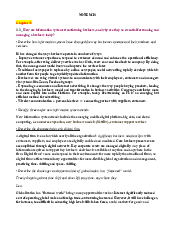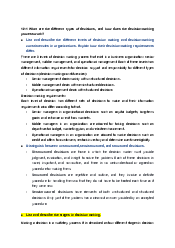







Preview text:
1. Which of the following traditional solutions enables manufacturers to deal with uncertainties in the supply chain? A) Safety stock D) Demand planning B) Continuous replenishment E) Perfect information C) Just-in-time strategies
2. A distortion of information about the demand for a product as it passes from one entity to the
next across the supply chain is called the ________ effect. A) network D) whirlpool B) bullwhip E) diffraction C) ripple
3. What event marked the beginning of e-commerce?
A) The first product sold online
D) The first paid advertisements B) The first domain name placed on a website registered
E) The first product advertised C) The first e-mail sent online
4. A marketplace extended beyond traditional boundaries and removed from a temporal and
geographic location is called a(n): A) exchange. D) e-hub. B) marketspace. E) net marketplace. C) online marketplace. 5. When did e-commerce begin? A) 1965 B) 1983 C) 1995 D) 1999 E) 2000
6. All of the following are specific security challenges that threaten the communications lines
in a client/server environment except: A) phishing D) radiation. B) tapping. E) sniffing. C) theft and fraud.
7. All of the following are specific security challenges that threaten corporate servers in a
client/server environment except: A) hacking. B) malware. C) denial-of-service attacks. D) sniffing. E) vandalism.
8. All of the following are specific security challenges that threaten corporate systems in a
client/server environment except: A) theft of data. B) copying of data. C) alteration of data. D) radiation. E) hardware failure.
9. Which of the following refers to policies, procedures, and technical measures used to prevent
unauthorized access, alteration, theft, or physical damage to information systems? A) Security D) Algorithms B) Controls E) Identity management C) Benchmarking
10. Which of the following refers to all of the methods, policies, and organizational procedures
hat ensure the safety of the organization's assets, the accuracy and reliability of its accounting
records, and operational adherence to management standards? A) Legacy systems D) Security policy B) SSID standards E) Controls C) Vulnerabilities
11. Most computer viruses deliver a: A) worm. D) keylogger. B) Trojan horse. E) payload. C) driveby download.
12. Which of the following statements
about wireless security is not true?
A) SSIDs are broadcast multiple times and can be picked up fairly easily by sniffer
D) Intruders can force a user's NIC programs.
to associate with a rogue access
B) Radio frequency bands are easy point. to scan.
E) Bluetooth is the only wireless
C) An intruder who has associated technology that is not with an access point by using
susceptible to hacking by
the correct SSID is capable of eavesdroppers. accessing other resources on the network.
13. Which type of decision is calculating gross pay for hourly workers? A) Semi-structured D) Unstructured B) Procedural E) Ad hoc C) Structured
14. Which type of decision is deciding whether to introduce a new product line? A) Structured D) Nonrecurring B) Unstructured E) Predictive C) Recurring
15. Which of the following is not one of the Simon's four stages of decision making? A) Implementation B) Intelligence 3 C) Prediction E) Design D) Choice
16. Which of the following is not one of the five classical functions of managers? A) New product creator D) Organizing B) Deciding E) Controlling C) Planning
17. Which of the following BI tools or abilities has been driving the movement toward "smart cities"? A) OLAP D) Data mining B) Chi-square analysis E) Big data analytics C) Predictive analytics C) The infrastructure for
18. Which of the following statements best collecting, integrating, and describes the term business analyzing business data intelligence?
D) Information systems involved A) Software developed in business decision making exclusively for business E) Enterprise systems used to management make business decisions
B) The tools and techniques used to analyze and understand D) Business analysts business data E) Senior executives
19. BI that is designed to determine the most likely effects of changes in the business environment is called: A) statistical modeling. D) big data analytics. B) environmental analytics. E) parameterized report C) predictive analytics.
20. CryptoLocker is an example of which of the following? A) Worm D) Evil twin B) SQL injection attack E) Ransomware C) Sniffer
21. Which of the following statements about Internet security is not true?
A) The use of P2P networks can expose a corporate computer to outsiders.
B) A corporate network without access to the Internet is more secure than one that provides access.
C) Wi-Fi networks are not vulnerable to security breaches.
D) Instant messaging can provide hackers access to an otherwise secure network.
E) Smartphones have the same security weaknesses as other Internet devices. 22. A Trojan horse:
A) is software that appears to be benign but does something other than expected.
B) is a virus installed as a drive-by download.
C) is malware named for a breed of fast-moving Near-Eastern horses.
D) installs spyware on users' computers.
E) is a type of sniffer used to infiltrate corporate networks.
23. Which of the following provides a suite of integrated software modules for finance and
accounting, human resources, manufacturing and production, and sales and marketing that
allows data to be used by multiple functions and business processes?
A) Process management software D) CRM software B) ERP systems E) Supply chain management C) Groupware systems
24. Enterprise software is built around thousands of predefined business processes that reflect: A) government regulations. D) cutting edge workflow B) industry benchmarks. analyses. C) best practices. E) the firm's culture.
25. Which of the following enables a company to tailor a particular aspect of enterprise software
to the way a company does business? A) Configuration tables D) Middleware B) Web services E) Groupware C) Data dictionaries
26. A network of organizations and business processes for procuring raw materials,transforming
these materials into intermediate and finished products, and distributing the finished products to customers is called a(n): A) distribution channel. D) marketing channel. B) supply chain. E) information system. C) value chain.
27. In the supply chain, components or parts are referred to as: A) upstream materials, D) intermediate products. organizations, and processes.
E) downstream organizations and B) raw materials. processes. C) secondary products.
28. Which of the following refers to a company's suppliers, the suppliers' suppliers, and the
processes for managing relationships with them?
A) Supplier's internal supply chain
D) Upstream portion of the B) Logistics supply chain supply chain C) Downstream portion of the
E) On Contract supplier's chain supply chain
29. Distribution and delivery of products to retailers is part of the:
A) downstream portion of the chain. supply chain.
D) supplier's internal supply chain. B) external supply chain.
E) midstream portion of the supply
C) upstream portion of the supply chain.
30. Uncertainties in the supply chain often lead to: A) declines in production. plans.
B) increases in inventory across D) the bull whip effect. all tiers.
E) a reduction in safety stocks.
C) strategic changes in production
31. What standards are referred to when discussing universal standards as a unique feature of e- commerce?
A) Internet technology standards D) Universal advertising and
B) Common spoken and written media format standards languages E) EDI standards
C) Universal measuring standards
32. All of the following are unique features of e-commerce technology, except:
A) personalization/customization. D) richness. B) interactivity. E) global reach.
C) price discrimination.
33. Which of the following dimensions of e-commerce technology involves engaging consumers
in a dialogue that dynamically adjusts the experience to the individual? A) Ubiquity D) Interactivity
B) Personalization/customization E) Information density C) Richness
34. The effort required to locate a suitable product is called: A) price discrimination. D) shopping costs. B) search costs. E) location costs. C) menu costs.
35. Information density refers to the:
A) richness–complexity and content–of a message.
B) total amount and quantity of information delivered to consumers by merchants.
C) total amount and quantity of information available to all market participants.
D) amount of information available to reduce price transparency.
E) amount of physical storage space needed to store data about a specific entity, such as a product or consumer.
36. Selling the same goods to different targeted groups at different prices is called: A) cost customization. D) cost personalization. B) cost optimization.
E) price discrimination. C) price gouging.
37. Compared to traditional goods, digital goods have: A) low marginal costs of
C) lower initial production costs. production. D) higher inventory costs. B) higher delivery costs. E) higher marginal costs.
38. Which of the following is the first step in the knowledge management value chain? A) Feedback D) Store B) Acquire E) Apply C) Disseminate
39. Which of the following is not one of the six main analytic functionalities of BI systems for
helping decision makers understand information and take action? A) Production reports D) Forecasts, scenarios, and B) Parameterized reports models
C) Business case archives E) Drill down
40. Which of the following are most likely to rely primarily on the drill-down functionality of BI
for their decision-making needs? A) IT developers B) Middle managers C) Operational employees
41. Which of the following statements best describes the relationship between collaboration and knowledge management?
A) Collaboration is impossible without knowledge.
B) Knowledge is impossible without collaboration.
C) Knowledge is useful only when shared with others.
D) As knowledge improves, so does collaboration.
E) Knowledge is the result of collaboration.
42. The text defines ________ as the flow of events or transactions captured by an organization's system. A) information D) knowledge B) data E) experience C) wisdom
43. Changing organizational behavior by sensing and responding to new experience and knowledge is called: A) change management.
D) organizational learning. B) knowledge leveraging. E) knowledge management. C) the knowledge value chain. 7
44. What is the last value-adding step in the knowledge business value chain? A) Acquire C) Store B) Data and information D) Disseminate acquisition E) Apply
45. The set of business processes, culture, and behavior required to obtain value from
investments in information systems is one type of: A) knowledge culture. management capital. B) knowledge discovery. D) organizational routine. C) organizational and E) knowledge.
46. Specialized systems built for knowledge workers charged with discovering and creating new
knowledge for a company are called:
A) Knowledge Work Systems C) wikis. (KWS). D) COPs.
B) Learning Management Systems E) enterprise-wide knowledge (LMS). management systems.
47. Apple's Siri application is an example of: A) neural networks. D) intelligent agents. B) augmented reality. E) machine learning. C) AI.
48. Which of the following techniques is used for knowledge acquisition? A) Decision support systems D) Data mining
B) Transaction processing systems E) Content management system C) CAD
49. Which of the following is a computer-based system that attempts to emulate how humans think and act? A) Virtual reality systems D) Genetic algorithms B) Neural networks E) LMS C) AI technology
50. When there is no well-understood or agreed-on procedure for making a decision, it is said to be: A) undocumented. B) unstructured. C) documented. D) semi-structured. E) random 8



